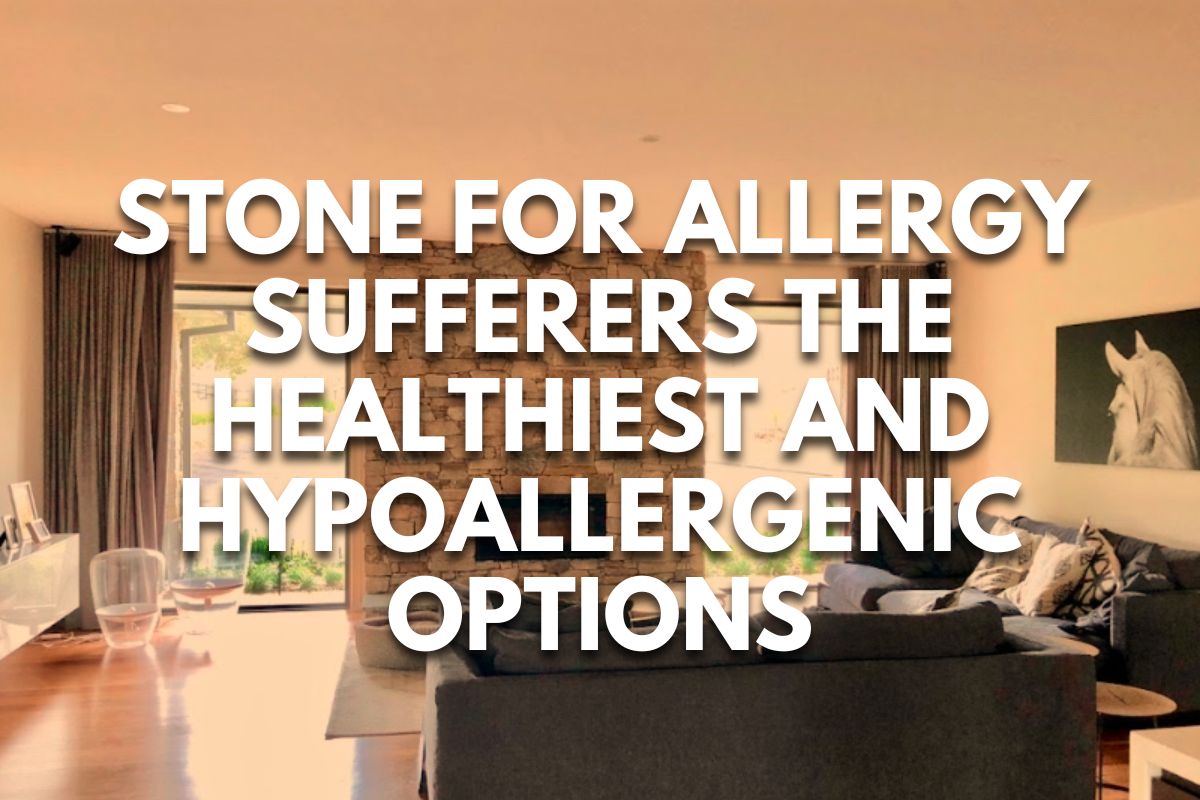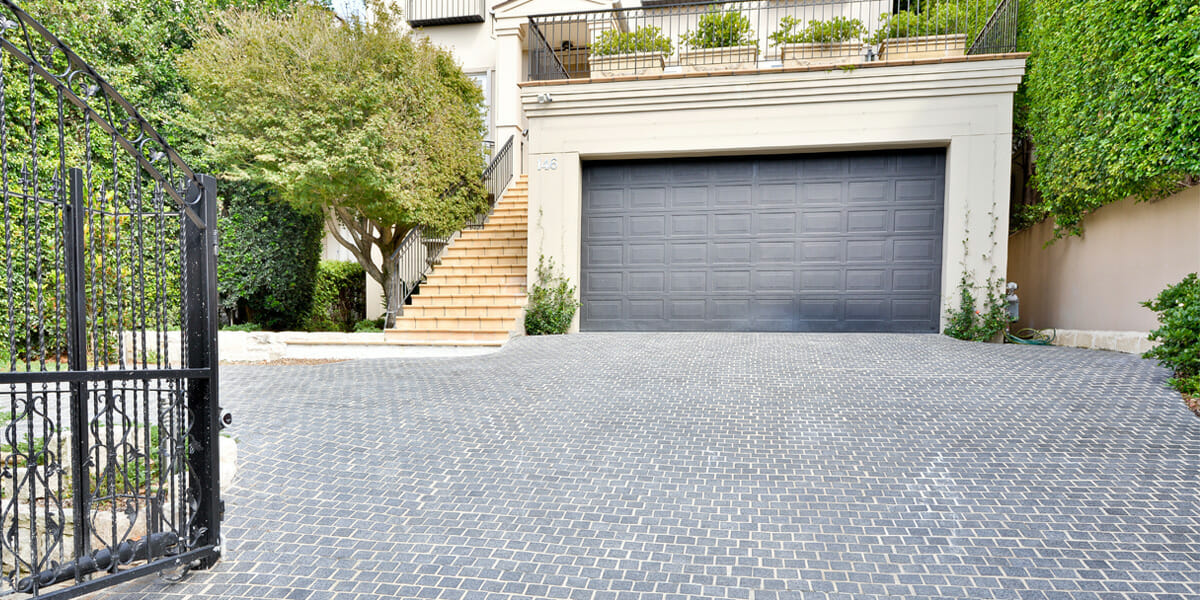
Allergy sufferers often struggle to find building materials that won’t aggravate their symptoms, with many standard options proving unsuitable.
Traditional materials like carpets and wood can trap allergens, causing persistent irritation and discomfort. Thus, feeling at ease in one’s home can be challenging.
Stone, a naturally hypoallergenic alternative, offers a solution. By opting for stone flooring and surfaces, those with allergies can enjoy a cleaner, healthier living environment free from allergen accumulation, ensuring comfort and well-being in every corner of their home.
Understanding Allergies and Indoor Air Quality
Understanding the relationship between allergies and indoor air quality is crucial for maintaining a healthy living environment.
Allergies are immune responses to dust, pollen, pet dander, and mould. These substances can accumulate in homes, particularly in materials like carpets and upholstery that trap and hold these particles.
Indoor air quality directly impacts allergy sufferers because poor air quality can exacerbate symptoms. Factors that degrade indoor air quality include inadequate ventilation, high humidity, and volatile organic compounds (VOCs) emitted from paints, furniture, and cleaning products.
Improving air quality involves controlling the source of allergens. This can be achieved by choosing hard-surfaced flooring like stone, which does not harbour allergens as easily as fibrous materials.
Stone surfaces are also easier to clean, reducing the accumulation of dust and pet dander. Additionally, ensuring proper ventilation helps dilute airborne contaminants and using air purifiers with HEPA filters can capture fine particulates.
Ultimately, selecting hypoallergenic materials and maintaining good air quality can significantly alleviate allergy symptoms, enhancing comfort and health in indoor spaces. This approach benefits those with allergies and contributes to a healthier environment for everyone in the home.
Characteristics of Hypoallergenic Stone
Hypoallergenic stones possess several characteristics that make them ideal for allergy sufferers:
- Non-Porous Surface: Hypoallergenic stones like granite and marble have non-porous surfaces that resist the accumulation of allergens such as dust, pollen, and pet dander, making them easier to clean and maintain.
- Smooth Texture: Smooth textures of hypoallergenic stones prevent the trapping of allergens, unlike rough surfaces that can harbour particles and contribute to allergy symptoms.
- Resistance to Mould and Mildew: Many hypoallergenic stones naturally resist mould and mildew growth, reducing the risk of allergen exposure in damp environments.
- Chemical-Free: Hypoallergenic stones are free from harmful chemicals and volatile organic compounds (VOCs) commonly found in synthetic materials, further minimising potential triggers for allergy symptoms.
- Durable and Long-Lasting: Hypoallergenic stones are durable and long-lasting, providing a sustainable solution for allergy-friendly environments while maintaining their hypoallergenic properties over time.
Types of Hypoallergenic Stone
Several types of hypoallergenic stones offer allergy sufferers a range of options for their surfaces:
- Granite: Known for its durability and resistance to allergens, granite is a popular choice for countertops and flooring. Its dense composition and non-porous surface make it easy to clean and maintain, reducing the accumulation of allergens.
- Marble: With its smooth texture and elegant appearance, marble is another hypoallergenic option suitable for various applications. Like granite, marble is non-porous and resistant to allergen buildup, making it ideal for allergy-sensitive individuals.
- Quartz: Engineered quartz countertops offer hypoallergenic benefits due to their non-porous surface and resistance to stains and scratches. Quartz surfaces are composed of natural quartz crystals combined with resins, resulting in a durable and low-maintenance material that minimises allergen exposure.
- Slate: Slate is a natural stone known for its durability and resistance to allergens. Its smooth surface and non-porous nature make it suitable for flooring, countertops, and outdoor applications, providing a hypoallergenic option for various environments.
- Soapstone: Soapstone is a dense, non-porous stone that resists allergen accumulation and is resistant to stains and heat. Its unique appearance and durability make it a popular choice for countertops and sinks in allergy-friendly kitchens and bathrooms.
Benefits for Allergy Sufferers
For allergy sufferers, choosing hypoallergenic stone surfaces offers numerous benefits:
Firstly, hypoallergenic stones like granite, marble, quartz, slate, and soapstone have non-porous surfaces that resist the accumulation of allergens such as dust, pollen, and pet dander. This reduces the potential triggers for allergy symptoms, promoting a healthier indoor environment.
Secondly, these stones are easy to clean and maintain, requiring simple wiping or mopping to remove allergens and maintain cleanliness. Their smooth textures prevent the trapping of allergens, unlike rough surfaces that can harbour particles.
Furthermore, hypoallergenic stones are often resistant to mould and mildew growth, reducing the risk of allergen exposure in damp environments.
Moreover, these stones are free from harmful chemicals and volatile organic compounds (VOCs) commonly found in synthetic materials, minimising potential triggers for allergy symptoms.
Overall, choosing hypoallergenic stone surfaces can significantly improve the quality of life for allergy sufferers by creating cleaner, healthier, and more comfortable indoor spaces.
Considerations for Allergy-Friendly Design
When designing allergy-friendly spaces, several considerations can ensure the optimal use of hypoallergenic stone:
- Material Selection: To minimise allergen accumulation, choose hypoallergenic stones such as granite, marble, quartz, slate, or soapstone for countertops, flooring, and wall cladding.
- Sealing: Ensure proper sealing of stone surfaces, especially in areas prone to moisture, to prevent the growth of mould and mildew and maintain the stone’s hypoallergenic properties.
- Ventilation: Incorporate adequate ventilation systems to promote airflow and reduce indoor allergen levels. Proper ventilation helps dilute airborne contaminants and maintain indoor air quality.
- Maintenance: Implement regular cleaning schedules using non-toxic, hypoallergenic cleaning products to remove dust, pollen, and other allergens from stone surfaces.
- Furniture and Accessories: Choose furniture and accessories made from hypoallergenic materials such as wood, metal, or glass to complement the allergy-friendly design of the space.
Cleaning and Maintenance Tips
Maintaining hypoallergenic stone surfaces requires simple yet effective cleaning and maintenance routines:
- Regular Cleaning: Wipe stone surfaces with a damp cloth or mop to remove dust, pollen, and other allergens. To avoid damaging the material, use a mild, pH-neutral cleaner designed for stone surfaces.
- Avoid Harsh Chemicals: Avoid abrasive cleaners or acidic substances like vinegar and lemon juice, as these can etch or dull the stone’s surface.
- Sealing: Ensure stone surfaces are properly sealed to prevent moisture absorption, mould, and mildew growth. Reapply sealant as needed according to the manufacturer’s instructions.
- Immediate Spill Cleanup: Quickly clean up spills to prevent stains and avoid potential mould growth. Use a soft cloth or sponge to blot spills rather than rubbing, which can spread the substance and worsen stains.
- Preventive Measures: Place mats or rugs at entryways to trap dirt and debris before they reach stone flooring. Use coasters or trivets under hot or acidic items to protect stone countertops from damage.
Environmental and Sustainability Considerations
When considering hypoallergenic stone options for allergy sufferers, it’s essential also to prioritise environmental and sustainability factors.
Many hypoallergenic stones, such as granite, marble, and slate, are natural materials sourced from quarries. When responsibly quarried and processed, these stones have minimal environmental impact compared to synthetic alternatives.
Furthermore, stone surfaces are durable and long-lasting, reducing the need for frequent replacements and minimising waste. Additionally, some stone varieties, like soapstone, require minimal energy for extraction and processing due to their relatively soft nature.
To enhance sustainability, consider sourcing stone from quarries that adhere to responsible mining practices and prioritise environmental conservation.
To ensure ethical and sustainable sourcing, look for certifications such as the Forest Stewardship Council (FSC) or the Natural Stone Sustainability Standard (NSC 373).
Professional Recommendations and Endorsements
Professional recommendations and endorsements further validate the use of stone for allergy sufferers:
- American Academy of Allergy, Asthma & Immunology (AAAAI): The AAAAI recommends hypoallergenic materials like stone to reduce indoor allergens and improve air quality, particularly for those with respiratory conditions.
- National Institute of Environmental Health Sciences (NIEHS): NIEHS endorses using stone surfaces to minimise allergen accumulation and emphasises the importance of maintaining a healthy indoor environment.
- Environmental Protection Agency (EPA): The EPA recognises stone as a low-allergen material and promotes its use in building design and renovation to mitigate indoor air pollution and allergen exposure.
- Certifications and Standards: Look for stone products certified by organisations such as GREENGUARD or the Asthma and Allergy Foundation of America (AAFA) to ensure they meet stringent indoor air quality and allergen control standards.
These endorsements underscore the suitability of stone for allergy-sensitive individuals and provide assurance that choosing stone surfaces aligns with expert recommendations for creating healthier indoor spaces.
Conclusion
In conclusion, opting for stone surfaces is a proactive step towards creating an allergy-friendly home environment. By prioritising hypoallergenic materials, we can alleviate symptoms and improve overall well-being.
Take action today by considering stone for your next renovation or construction project, and breathe easier knowing you’ve made a choice that prioritises health and comfort.
More To Explore

Grey Granite Cobblestones for Driveways: Strength and Style
Grey granite cobblestones combine strength, safety, and timeless appeal, making them a popular choice for Melbourne driveways and outdoor spaces. Their natural flamed texture offers

Granite Wall Cladding Melbourne: Modern and Classic Appeal
Granite wall cladding brings both modern sophistication and classic charm to Melbourne architecture. Known for its durability and natural beauty, granite transforms façades, feature walls,


